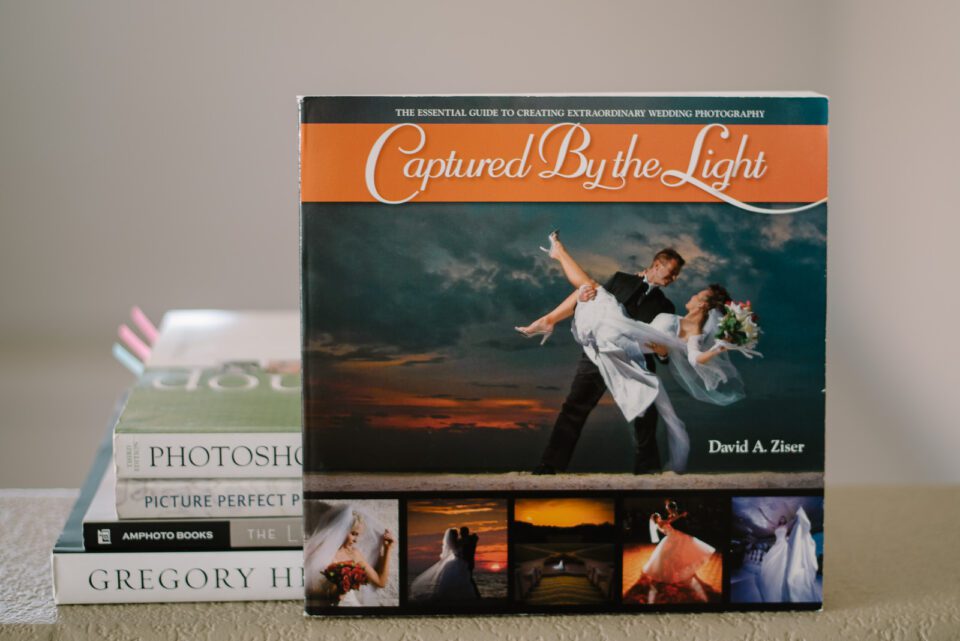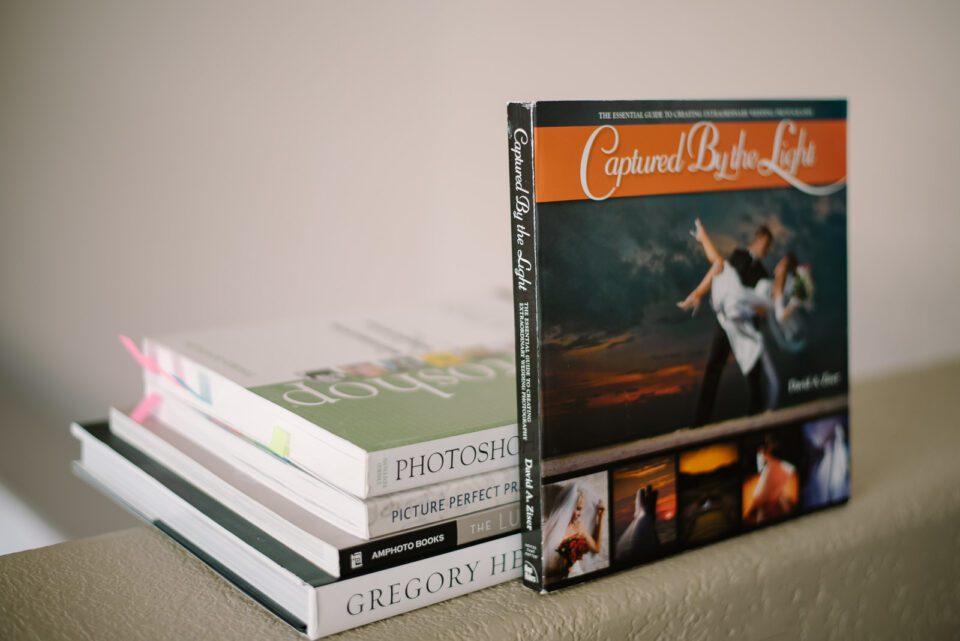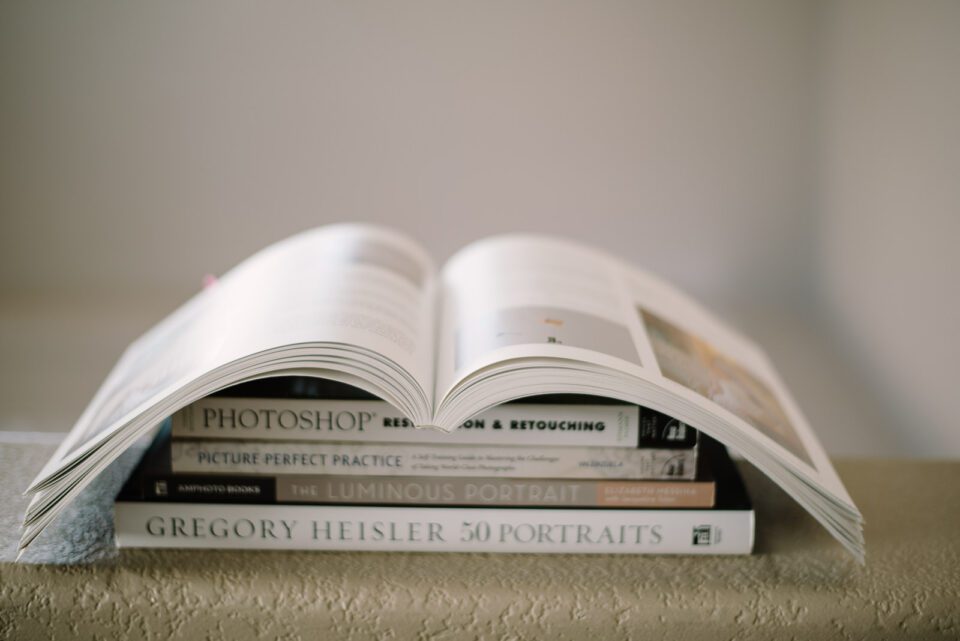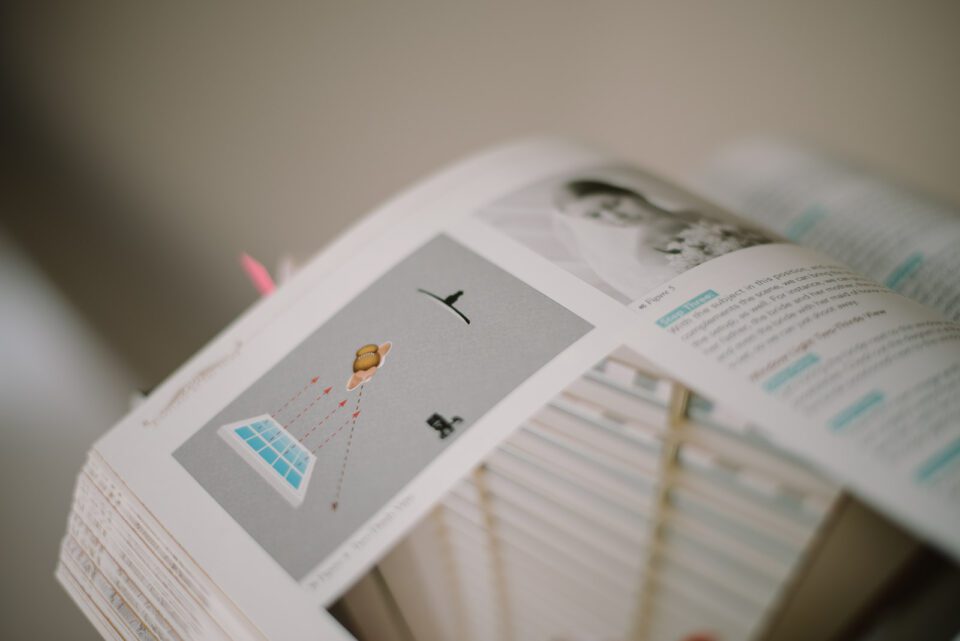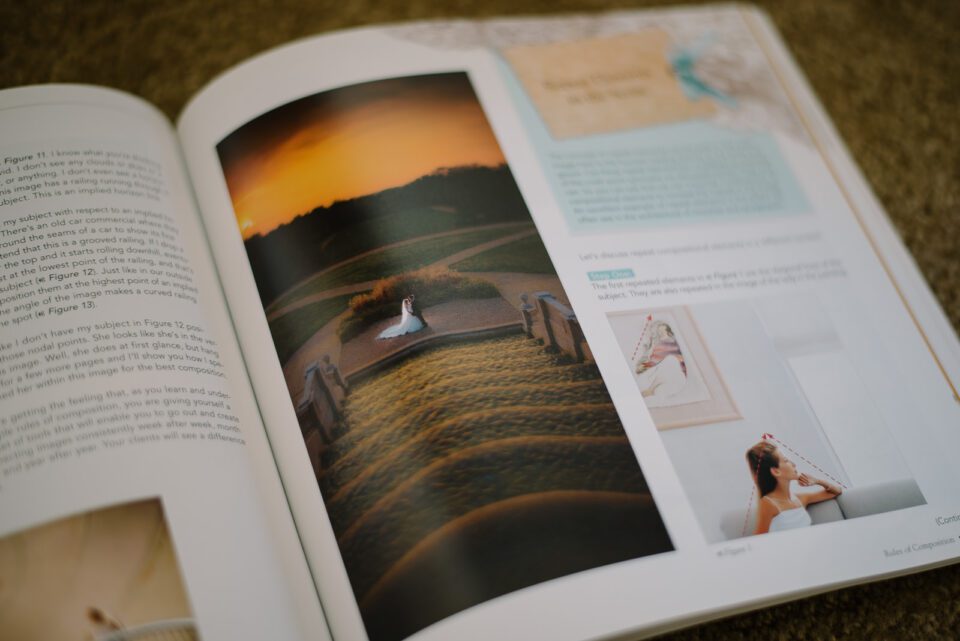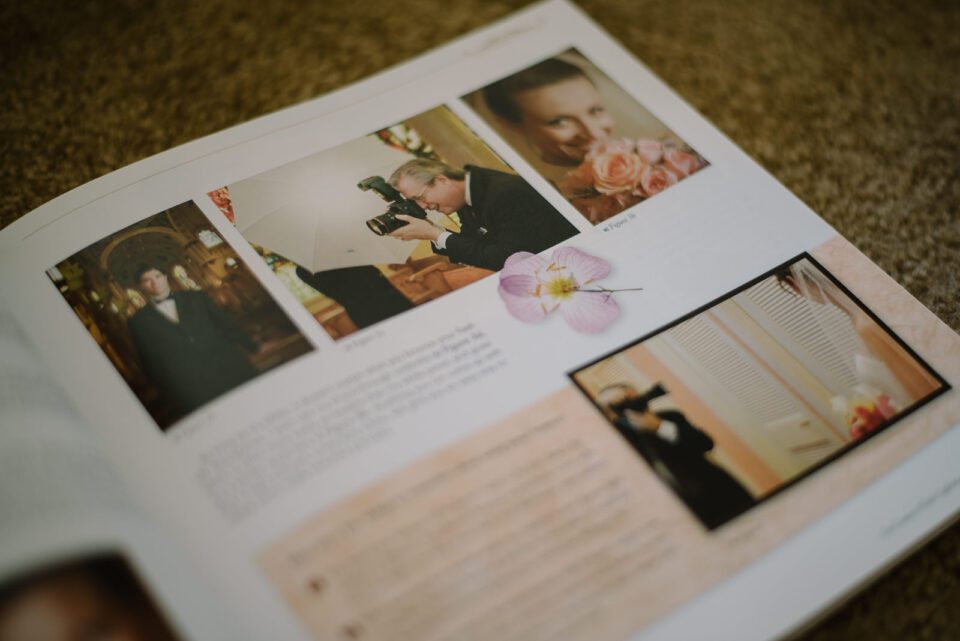You can tell by the photos of this book that it went through a lot of use in my hands. Back when I just started learning about wedding photography, I literally slept with this book left on my face. I figured it was only fair enough I added a review of Captured By The Light by David A. Ziser into the small stack of book reviews at Photography Life.
Just as any photographer would, I had my challenges with learning my photo equipment, and most importantly, learning how to properly utilize artificial light into my photographs. I searched high and low for information that could be useful in learning more. I first came across David Ziser back in 2009 when I started diving into wedding photography. David Ziser is a world-renowned wedding photographer and one of the most acclaimed instructors in the wedding industry. I was drawn to him and his knowledge, not only because I was eager to learn more, but also because David is an excellent teacher. While I love natural light in all of its shapes and forms, wedding photography can happen in any environment, which can be especially tough to deal with when shooting in low-light indoor or outdoor situations. I was always afraid of being in such environments, because I really had no idea how to deal with them. I knew that knowing how to utilize good light, irrespective of its source is something that separates a skilled photographer from an average shooter. I never wanted to be caught off-guard in a situation where I could not utilize artificial light to my advantage.
Along from learning about strobe photography from Nasim at 2 AM in the morning (mind you, I had two little children to take care of) I signed up to all online classes of David Ziser at Kelby Training. After-all, it was a two-in-one combo; I could learn about wedding photography and how to light my subjects – both in one place. David Ziser always offers great tips on professional posing, how to compose a shot with subjects in them, non-complex lighting solutions, creative lighting solutions, etc. I watched and stalked David Ziser for quite some time. When this book was published, I can assure you that I was one of the first ones to purchase it. For me, having a book I can carry around and reference whenever I can is important. I got through this book multiple times and built on it. Here is the interesting part in learning a new craft – it can come handy during ANY photography session. If you are learning from a master of his craft, then rest assured you will find use for it. My first year into wedding photography I shot only 2 weddings, close to 40 business-related headshots, along with some product photography. Although the first year I didn’t get to use the techniques I learned during weddings, the techniques were very successfully utilized on my business photography subjects, hence giving me a good battleground to practice my skills on.
So, let’s check out what this book has to offer. I’ve read some reviews online which picked up on how “old style” the example photos were. What I want to remind our readers is that this book does not comprise of million glamorous shots that are shot with a very shallow depth of field, edited the heck out and cropped beyond recognition (nothing wrong with that if it works for some). It contains examples of well-thought compositions which take into account lines, repetitive structures, rules of thirds, symmetry, correct framing, vanishing points, etc. I love most of the example photos in this book and some I could tweak according to my own taste. Every photographer offers a different style. While some of the photos in this book may not be to everyone’s liking, what matters the most is the amount of knowledge the book carries. And at 276 pages, there is plenty of it!
The book has 11 chapters and takes you through the whole process of photographing a wedding, from the beginning to the delivery stage. You will gain knowledge from packing your gear, making the bride look good in the frame all the way to the point of delivering albums to your clients.
Let’s break it down into chapters.
Chapter 1: Making your Clients Look Good, Correct Posing and Positioning
David Ziser starts off this chapter by saying: “If it was good enough for Rembrandt, it is good enough for me”. As wedding photographers it falls unto us to make our clients look and feel beautiful. This is one of the “once in a life time” moments in their lives and the least you can do is to make them look flattering in their photos. This chapter is kept really easy to follow for the reader and it contains multiple simple rules which you can follow wedding after wedding.
Chapter 2: Getting the Correct Exposure
This should be a big one for any photographer. You can and you should fix exposure in post-processing when you have to. But if you can get it right in the camera and save yourself valuable time while editing, kudos to whomever taught you that. It is a relatively small chapter, but it is enough to teach you what to watch for and how to correctly set the exposure while photographing in different case scenarios.
Chapter 3: On-Camera Flash Lighting Techniques
This chapter deals with utilizing a flash mounted on your camera. You will learn how to bounce light correctly so that your subjects are evenly lit. You will go through different case scenarios of balancing the existing ambient light with your flash unit. You will also have fun with learning how to utilize a zoom flash to create a certain ambiance during the ceremony (if and when you are allowed to use flash).
Chapter 4: Off-Camera Flash Lighting Techniques
This is a fairly large chapter addressing what David Ziser does best. Creating light subtly and beautifully with off camera lighting equipment. He walks you through the equipment that uses and presents different case scenarios with lots of diagrams and visual teaching tools one can easily follow. Often times photographers face a lot of problems while photographing big groups with artificial light. David explains in details what one needs to know and what should be done lighting-wise while photographing big groups. The case scenarios show how to correctly position your subjects, so that the entire group is well-lit and results are consistent every time you embark on photographing big groups indoors or outdoors, especially when the existing light is insufficient. There is so much more to this chapter starting from reflection problems and ending with adding creative light to make amazing photos. You will refer to this chapter quite a bit.
Chapter 5: Backlit Wedding Photographs
This chapter teaches the reader how to utilize the technique of backlighting to create halo, silhouette photos or to backlight the subject in order to bring in the background to create a whole story. Again, every shot in this chapter is a keeper for the couple. They involve the correct symmetry, concoction of elements, along with specific lighting technique which is bound to create spectacular shots.
Chapter 6: Using Natural Light
This chapter gets you equally covered without any artificial light. In case you forgot your flash or your assistant at home, you can pick up some great tips here 🙂 David teaches how to position your subjects so that the light wraps around them creating a cocoon of delicious and natural light both indoors and outdoors. You will learn to read the direction of light and how positioning of your subject relative to the light source can create different and refreshing results.
Chapter 7: Rules of Composition
Although every chapter carries a significant amount of information, the one on composition always gets my vote. This chapter was one of my favorites. It has a lot of great examples of utilizing different elements to make unique photos and will help you train a remarkable eye to capture those one-of-a-kind photographs. While you will learn a lot about symmetry, rule of thirds, infinity lines and involving geometrical shapes in your photos, this chapter will keep your attention engaged and will teach you to be more observant about your surroundings. Here you will find great techniques to help you create a difference in your portfolio.
Chapter 8: What is in David Ziser’s Camera bag
Although a bit outdated by now, if you would like to peek into David Ziser’s gear bag, this is your chance. David Ziser is a Canon shooter, whereas I photograph mainly with Nikon equipment. Despite the valuable information you might find in this chapter, don’t worry, the objective here is not to make you switch – just to understand what types of lenses, focal lengths and lighting equipment you might need to get the job done. Speaking of David’s equipment, he is known to shoot with pretty average gear! He is not one of those types who brags about a medium format digital back, or how a Zeiss Otus beautifully renders bokeh and wraps around his subjects – he typically shoots with pretty standard cameras (both APS-C and full-frame) and fairly inexpensive lenses (including some from Sigma). It was quite an interesting read. David goes through every lens he uses to show the type of shots one can capture.
Chapter 9: David Ziser’s workflow During the Wedding
Since David already taught you all the technicalities of taking the perfect shot, in this chapter he is taking you behind the scenes, as an accomplice, if you will. It is divided in 7 sections you will learn David’s approach towards each wedding from start to finish, in other words from packing his gear for the wedding till he hits the reception.
Chapter 10: David Ziser’s Workflow During the Reception
This chapter is a continuation of chapter 9 and demonstrates David’s workflow during the reception. It is one of the bigger chapters in the book with different steps and 17 parts. This extensive chapter puts to use what you have learned regarding indoor lighting with strobes and artificial lighting. In other words, this is one of the places the knowledge you’ve gained from the book comes very, very handy.
Chapter 11: The Final Presentation
In this chapter David explains the whole reasoning behind why we as wedding photographers should photograph and how we can make our services memorable till the end. It serves as a good reminder that we as photographers should stand behind our craft and work as hard as we can. We should finish the delivery process of the photos to our clients with such a bang, that it will only benefit us in the long run by creating more word-of-mouth referrals.
From David himself: “The finished product we deliver to our clients is more than just the images. The design and layout of the album, with the images presented in an exciting, storytelling manner, truly brings life to both the finished album and the story we are trying to tell with our photographs. To offer the client any less than that compromises our ultimate service to them”.
Conclusion
There are many types of wedding photographers and each have their own style. There are photographers who advertise themselves as documentary style, who like to imitate photojournalistic approach. There are other photographers who emphasize the importance of correctly posing shots to bring most out of their craft. Whichever way you would like to go, at the core, wedding photography is truly a combination of the above two. A good wedding photographer will know how to correct a mistake in the pose of their subjects so subtly, that the couple will not even notice. To some extent, it is still staging and stepping out the norms of photojournalism. The rest of the wedding is really documented as the photographer has very little say. At this point, all that is left is truly to document. So, knowing both sides of the craft will never hurt. This is where “Captured By The Light” comes in very handy. It has a chock full of information for any wedding photographer to learn from and to make their craft better. I find that starting off with a good and reliable foundation is essential. That is, of course, if you want to go further with the profession you chose. This is why I highly recommend this book to anyone who is interested in learning more about wedding photography.
Where to Buy
You can purchase a Kindle or paperback version of Captured by the Light: The Essential Guide to Creating Extraordinary Wedding Photography from Amazon.
The post Captured by the Light: Book Review appeared first on Photography Life.

